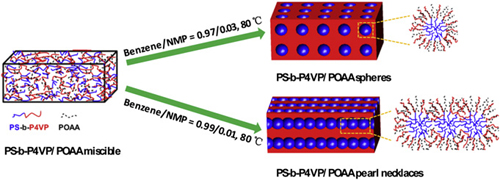
Formation of ordered microphase-separated nanostructures in PS-b-P4VP/POAA thin film blends after solvent annealing in benzene/NMP vapor mixture with different volume ratios.(WANG Qihua et al.)
Research physicists of the R&D Center of Lubricating and Protecting Materials of Lanzhou Institute of Chemical Physics, Chinese Academy of Sciences (CAS) have successfully applied solvent annealing in the self-assembly of hydrogen-bonded interpolymer complexes of block copolymer/homopolymer in thin film.
The researchers have produced ordered self-assembly structures of poly(styrene)-block-poly(4-vinylpyridine) (PS-b-P4VP)/poly(4,40-oxydiphenylenepyromellitamic acid) (POAA) blends in thin film through solvent annealing, where POAA chains selectively interact with P4VP blocks by strong interpolymer hydrogen-bonding. They then expose the PS-b-P4VP/POAA thin film blends to benzene/NMP (0.97/0.03, in volume) vapor mixture at 80℃, and obtain the ordered microphase-separated structures with PS spherical microdomains distributed within P4VP/POAA complexes matrix.
The researchers also find that different ordered self-assembly structures of the thin film can be achieved by changing the volume ratio of benzene to NMP in the vapor mixture. And when the thin film is annealed in benzene/NMP (0.99/0.01, in volume) vapor at 80℃, “pearl necklace” PS microdomains, which are resulted from coalescence of PS spheres due to increasing PS-selectivity of the mixture vapor, form a packed array parallel to the film surface. However, when the thin film is annealed at 80℃ without solvent environment, no obvious microphase separation is observed.
In recent years, there has been growing interest in the study of blends of diblock copolymers mixed with homopolymers as it enjoys various self-assembly structures and offers potential application to the nano field. Most of the self-assembly structures of diblock copolymer/homopolymer blends reported previously are achieved via thermal treatment at high temperature for a long time. Thermal treatment is necessary for the thermodynamic equilibrium of the blends but not applicable to some system, especially to the blends of diblock copolymer with a homopolymer which will be cured once treated at high temperature. However, solvent annealing may serve as an effective way to control the microdomain orientation and long-range ordering in block copolymer thin films, which is simple and needs no thermal treatment. And the current study just opens up new routes to the self-assembly of hydrogen-bonded interpolymer complexes of diblock copolymer/homopolymer.
The work has received support from the Main Direction Program of Knowledge Innovation of CAS and the National Program on Key Basic Research Project of China (973 Program). The report of the study has been published in Polymer (51 (2010) 4836e4842).
Further references:
Polymer paper
Page of WANG Qihua (corresponding of the author)

